EBOOK
Food & Drink E-Commerce: The Secret Sauce
Published: Apr 24, 2018
What you’ll get from this guide
Over the last few years, consumer appetite for buying food, drinks and meals online has seen huge growth, with spending increasing year-on-year, averaging 21.1% growth since 2013.
2017 was the biggest year yet for the industry, both in terms of sales – with the UK alone topping £11bn – and in terms of how food and beverage businesses are evolving their e-commerce propositions to capitalize on consumer demand.
In just one year, the industry saw Amazon, having made big steps into the market in 2016 with the launch of Amazon Pantry, stake its claim on owning the future of food with the multibillion dollar purchase of US retailer Whole Foods, promising to roll out free two-hour delivery for Prime subscribers across the US.
Seeking to get ahead of the inevitable entrance of Amazon into the UK grocery sector, the UK supermarket giants expanded their one-hour delivery offerings, making it just as practical to order dinner ingredients online as it would be to head down the road to the store.
Meal kit providers continued to disrupt the industry with their take on convenience, encouraging both Amazon and Walmart to enter the marketplace in an attempt to compete with market-leaders such as Blue Apron and Hello Fresh, with Walmart going so far as to bring meal kits offline and into its brick-and-mortar stores.
And if meal kits offer consumers the answer to ‘What’s for dinner?’, online take-outs continue to answer the question “…and who’s cooking?”. Domino’s is the solution for many, achieving record profits in 2017, with 97 million pizzas sold to UK households (the equivalent of one pizza every three seconds).
There’s also been a growth in online pure-play brands such as Brandless, selling direct to consumers and using the opportunities afforded by the internet to reconsider what it means to market food and drink brands.
As all of these developments reveal, there’s a wealth of ways for food and drink companies to make the most of e-commerce for their business, and whilst there’s no universal method, this guide will provide you with the ingredients necessary to build a recipe for success.
The 5 ingredients of a successful strategy
At the heart of any e-commerce strategy is the customer – understanding their motivations, needs and concerns is key to success.
So combining a few ingredients – the trends leading the way in 2017 outlined above, a sprinkle of the traditional marketing mix, and our own expertise of working with brands across the spectrum, from global businesses like Domino’s to local heroes like Farmison & Co – this guide will cover five areas where e-commerce is perfectly placed to help your brand become the number one option in a busy marketplace:
- Convenience
- Choice
- Conscious consumption
- Content
- Cost
Convenience: Bringing Delivery to Life Online
One of the biggest factors pushing customers towards online purchasing for their food and drink needs is that of convenience. The Hartman Group outlined the 4 key drivers for grocery shopping online as the below – and this is a common thread to all of them:

When we think of convenience in shopping, the answer is usually e-commerce. But for food and beverage brands, with perishable products that typically have a low margin relative to clothes or electronics, convenience via the online channel has not been something that can be reliably delivered until fairly recently.
Meal kit companies are a perfect example of the increasing expectation of convenience, providing consumers with easy-to-follow recipes for meals and precisely-measured ingredients with which to make them – all delivered directly to the customer’s door.
As supermarkets begin to offer ever expanding, hyper-specific delivery options, it’s clear that it’s these delivery propositions that are key to convenience and therefore driving demand.
Time
As any hungry consumer knows, time is of the essence when it comes to delivery. Highlighting the speed of delivery available allows customers to arrange for their purchase to arrive at the time they desire.
Luxury department store Fortnum & Mason highlights next-day delivery prominently on its homepage:
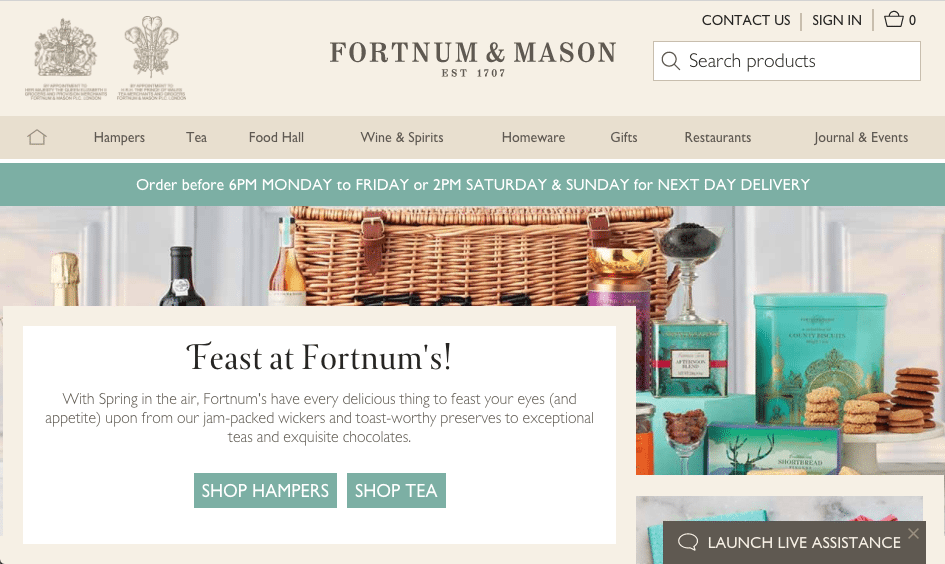
This type of message can be even more effective when served at the right moment – for example, via an on-screen Notification on the product page, or at check-out to secure that purchase.
Visual representations of time are also a useful tactic here: countdown timers can be leveraged to let customers know how long they have left to purchase in order to receive next-day delivery, encouraging them to convert.
Transparency around delivery times is also important for building brand loyalty and encouraging return visits. Consumers may appreciate speedy delivery, but they’ll also be less likely to visit again if they have a bad experience the first time they order because they weren’t aware of delivery cut-off times, and instead have to wait until Monday for their purchase.
Cost
Delivery costs have long proven to be a barrier to purchase for many customers, with 93% of respondents on one study claiming they’d spend more if shipping was free on their purchase. Businesses can make the most out of this by offering deals on free shipping that benefit both parties.
One option would be to provide free delivery to customers in exchange for their email address, allowing businesses to keep in contact with further offers and savings.
Delivery can also be a great mechanism to increase average order values. UK supermarket Iceland encourages consumers to add more items by implementing a delivery threshold. One of the first things customers are told as they enter the website is that they can receive free next-day delivery if they spend over £35. This provides customers with a clear delivery proposition, whilst also increasing average order value as shoppers with a £25 shopping basket add extra items to reach the minimum threshold for free delivery.

This threshold could be further highlighted by combining a Dynamic Promotion with a Progress Bar showing how close the customer is to receiving free delivery.
Testing out what works for you is the best strategy, as Jennifer Hey, Head of Digital & Customer Experience at award-winning butcher Farmison & Co explains:
We’re currently testing our delivery threshold to make sure that we get it right. For Farmison, it’s really important that we’re offering the right incentive to each customer to help them to convert, and Yieldify is a key part of this testing strategy.
As we deliver fresh produce, it’s important to educate our customers about our delivery and to inform them that the produce we’re sending out is getting to them fresh, as quickly as possible and for a reasonable cost. We have lots of plans to utilise on-site messaging to help with this education piece soon.
Location
While delivery from store to door is pretty convenient for most customers, other propositions are gaining popularity with consumers: a 2013 survey found that 79% of participants had used an online click-and-collect service in the past twelve months.
Allowing customers to order online and collect in a local branch offers plenty of convenience, particularly in food shopping. Customers can order knowing that all of the products they need will be ready for them to pick up – there’s no risk that they’ll travel into town only to find the store doesn’t stock sesame oil. It also allows for payments to be made online, with receipts sent to their email and a speedier cash-free transaction in-store.
Specialist food retailer Japan Centre teamed up with AtHand, a company that deals exclusively in providing click-and-collect services between restaurants and consumers. For people who live near a favourite restaurant, or perhaps travel past one on their commute home from work, AtHand offer an easy way to source a ready-made meal that can be picked up at the time of their choosing. Making customers with items in their basket aware of convenient delivery propositions like this could make all the difference in securing that conversion.
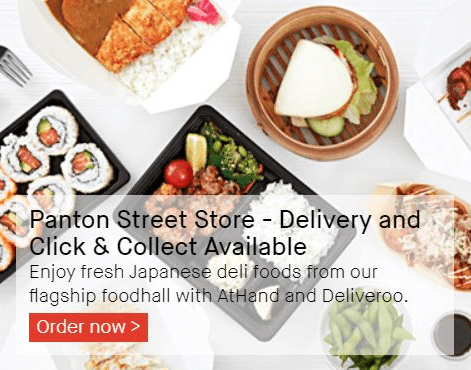
Choice: Curating the Customer Experience
Food culture has changed dramatically in the last thirty years, and a huge part of that has been influenced by the internet. Shoppers can instantly summon dozens of recipes for even the most obscure of dishes. Once-exotic ingredients are now just a click away, and as a result, entire cuisines have opened up to the mainstream.
E-commerce is, in many ways, the medium best suited for this new world. Online stores aren’t confined by shelf-space, and customers don’t have to trawl the aisles to find their kimchi – they simply type it in the search box.
Whilst this is undoubtedly a good thing, it also provides certain challenges. With so many options, consumers face being overwhelmed by choice. How do you make sure they choose your website over the dozens of competitors? And once they’re on the site, how do you help them pick the products that best suit their needs? It’s important to do all you can to aid their discovery.
Referral marketing
A personal recommendation is 4 times more likely to lead to a purchase, and there are few things more personal than the food we eat. Acquiring new customers today is a challenge for food and beverage brands, but disruptive companies like Graze have mastered it, using referral marketing to build awareness with new customers and loyalty with their existing ones:

Existing customers of Graze are given a code that they can share with their friends to encourage them to sign up to the service. The friends get their first box free, as well as the opportunity to choose future boxes to ensure they stay signed up to receive deliveries. And in exchange for spreading the word about Graze, the existing customer gets a reward. This varies depending on current offers but is usually either discount on future purchases or a free snack box.
Curation and Recommendations
Once customers are on your website, they may still be overwhelmed by the options, so it’s important to consider ways to improve their customer journey and cater the website to their specific needs. Meal kit companies are a great example of curation, delivering products tailored to personal preferences so that consumers don’t have to spend time worrying about what they’ll eat for dinner that night.
Recommendations, cross-selling and upselling present the perfect opportunity to help customers choose their meals. Pizza delivery company Firezza, understanding that its perceived quality and authenticity is key to its appeal, offers customers the opportunity to elevate their meal, with a suggestion of premium mozzarella. This type of message could be displayed via an onsite Notification, informing customers of a potential upgrade that they might not have seen amongst the dozens of customisation options on the site.

More specialized products might need to provide more information to the customer to aid their decision, but how can this be done in an engaging way?
Online wine club First Leaf understands that not all of its visitors will know enough about wine to feel confident signing up, so they put together a quiz to determine new customers’ taste profiles.
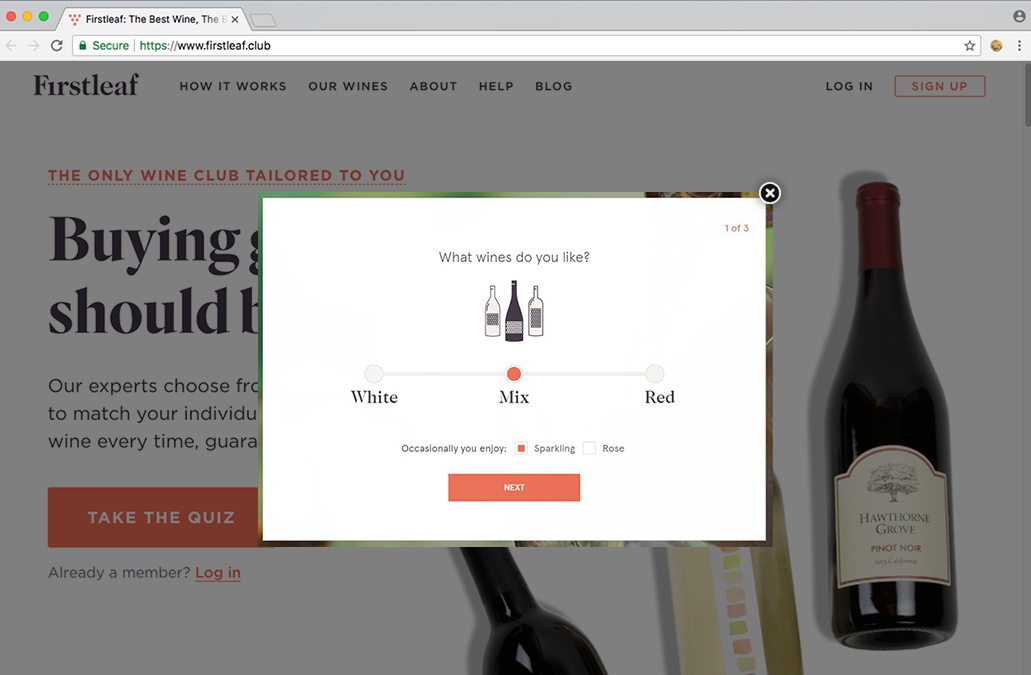
The quiz is cleanly presented and asks simple questions about the user’s preferences, including the preferred colour of the wine, whether they’d enjoy bottles of sparkling or rosé wines, and if they have a preference over the country of origin. With this information, First Leaf can provide a selection of wines the customer will be most likely to enjoy.
Finally, they ask for contact details in exchange for the results, allowing follow-up email marketing.
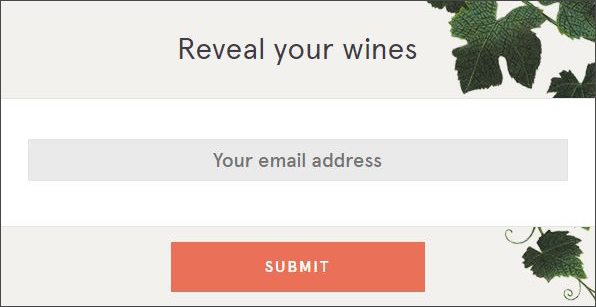
It doesn’t need to be complicated. Online grocer Heartier showcases its full range with a simple corner Notification, encouraging curious consumers to discover more of its products:
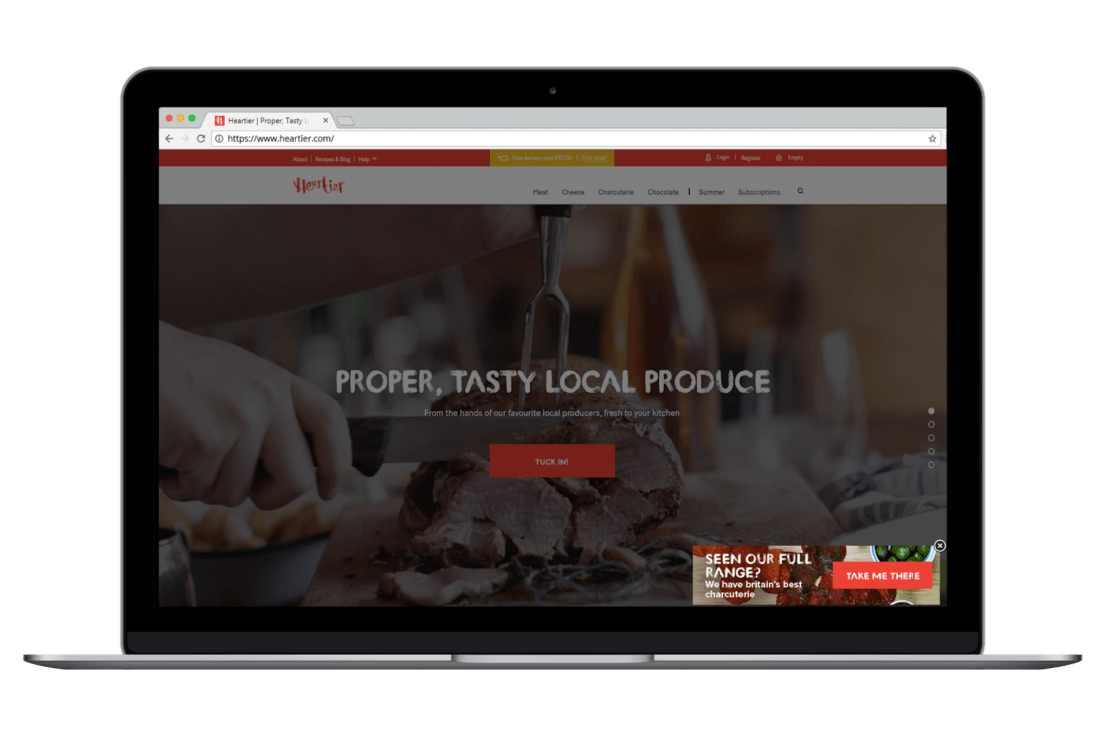
Conscious Consumption
Over the past decade, consumers have become more and more aware of what goes into the products they buy, and how those products arrive at their door. There are various motivations behind this interest, but all of them speak to a more conscious consumer who thinks about what they buy, and why they buy it.
In 2015, Nielsen revealed figures showing that two-thirds of consumers polled globally would be willing to pay more to ensure their purchases matched their ethical concerns. When quizzed further, consumers revealed specific interests in sustainability, natural or organic ingredients and companies known for a commitment to social improvement.
These aren’t the only concerns of conscious consumers – there are also active movements for healthier food and ‘artisanal food’, supporting small, independent businesses that are often seen to be representing a ‘craft’.
These trends towards more mindful consumption allow for businesses to enter markets that have large audiences willing to pay a premium for products that meet their values. For those targeting conscious consumers, a high level of trust in both the product and business is the key to success – but how to build this?
Highlighting USPs
One way to build trust is to demonstrate your company’s USPs, highlighting the elements that will chime with your particular audience’s needs. Online butcher Farmison & Co dedicates an entire section of its website to the breeds of animal it uses in its products:
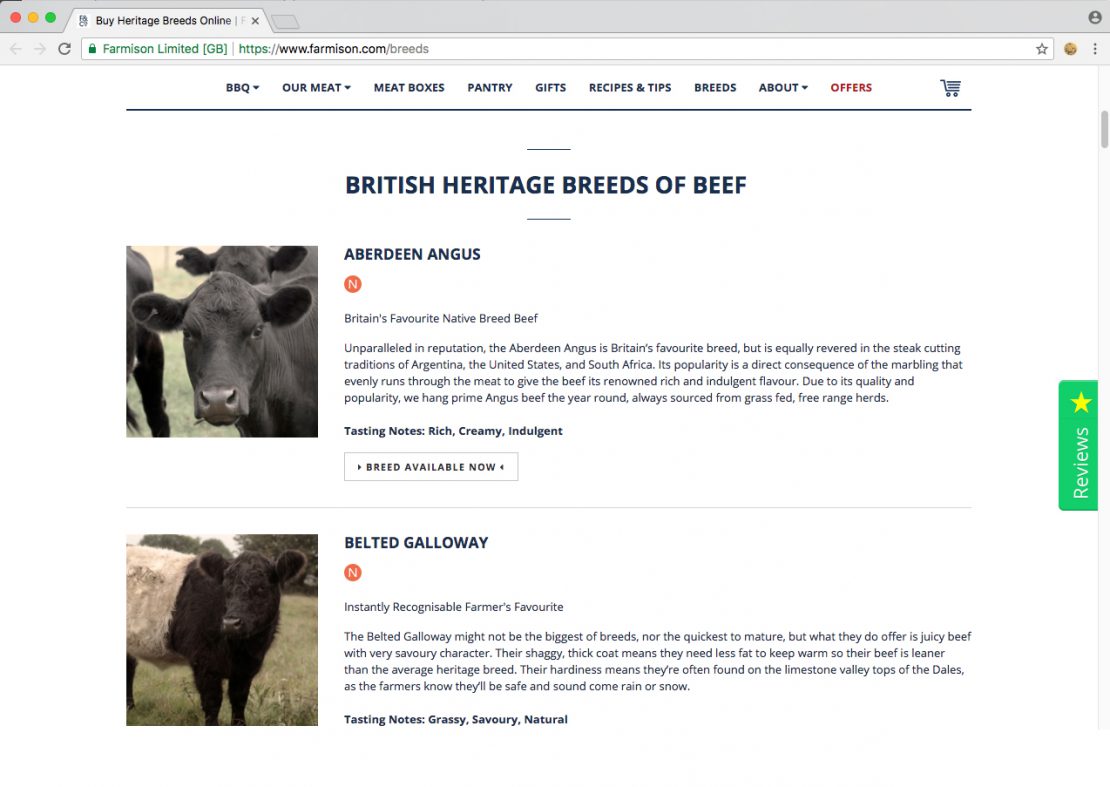
As well as going into detail about the heritage of each breed sold through its store, Farmison & Co notes whether each animal is a rare or native breed. This demonstrates commitment by the company towards supporting local farming communities, as well as continuing traditions and breeds that might otherwise die out.
Not forgetting the core function of their business, though, Farmison & Co also feature tasting notes for each animal – ensuring customers can buy the perfect meat for the occasion whilst knowing they’ve purchased in an ethical manner. Jennifer Hey, Head of Digital & Customer Experience at Farmison shared more on how the brand creates trust on-site:
“Something that works really well for us is displaying our rewards for all to see – we’ve won Online Butcher of the Year 2 years in a row, we’re really proud of this, so it’s a really key message we want our customers to see as a trust signal. We have this on our marketing emails, in our PPC copy and more places onsite, but where Yieldify has helped is to get it in front of users wherever they land on our site and in a more noticeable way, without interrupting the customer journey.”
Utilising Social Proof
Social proof is a great way to demonstrate the quality of what you’re doing. Meal kit provider Mindful Chef specialises in home-delivered kits that are both ethically-sourced and healthy. They speak confidently of their values, but you don’t have to take their word for it:
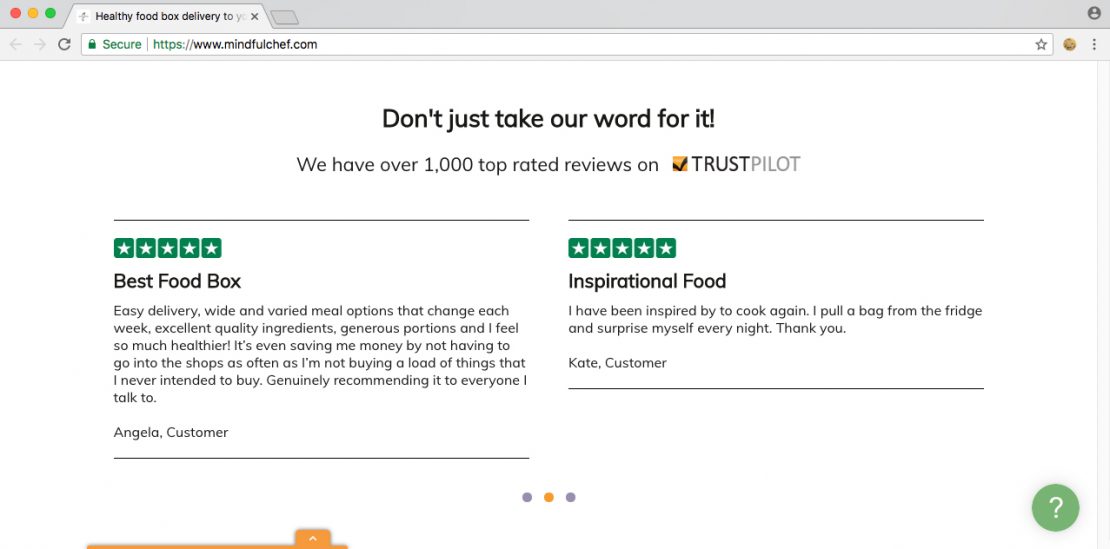
The homepage features plenty of reviews from Trustpilot, but that’s not all. To highlight these powerful testimonials to the right audience at the right time i.e. new users who might need reassurance, they use these reviews in on-site remarketing campaigns, such as this one which targets exiting new users, who aren’t on their mailing list, to get their email address in exchange for healthy recipes. This method provides social proof, and highlight’s USPs, showing consumers that like-minded individuals have already signed up to the service.
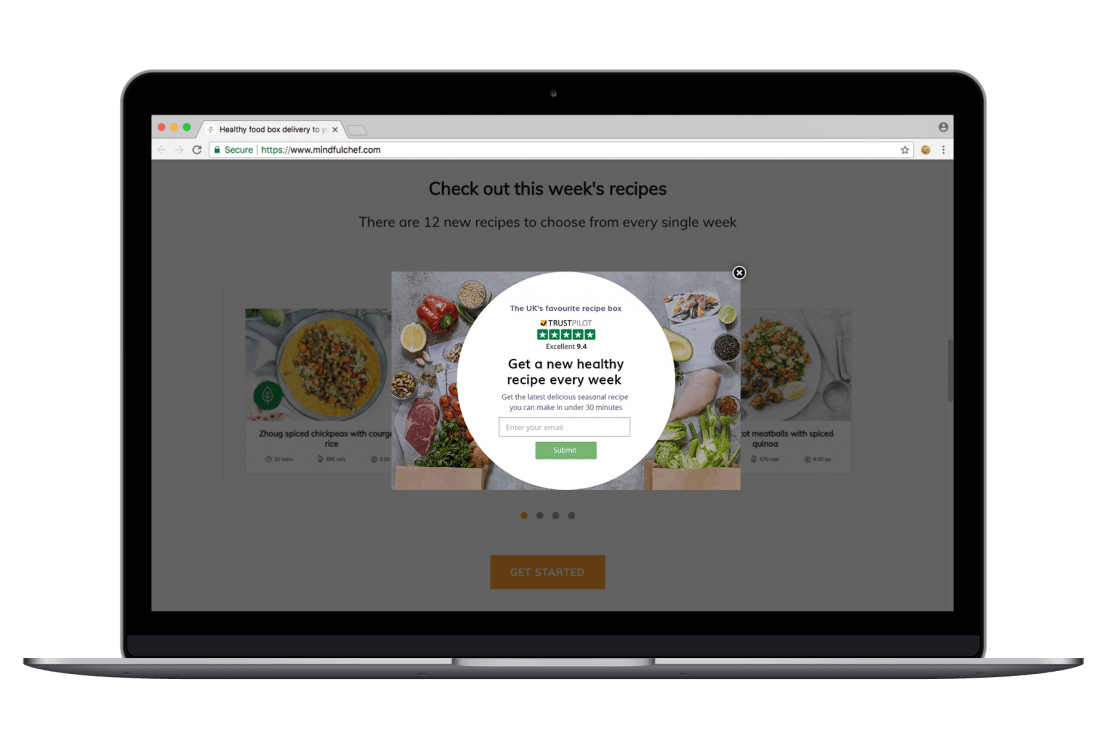
This method provides social proof and highlights USPs, showing consumers that like-minded individuals have already signed up to the service.
Content
Besides being a place to buy food, the internet is a place to discover food – be that new cuisines, more ethical providers or, increasingly, recipes. In no group is this more prevalent than 25-34 year-olds, who are not only the second biggest market for online groceries, but are also the most likely to use their smartphones or tablets whilst cooking.
Whether they’re following online recipes whilst they cook or watching YouTube videos to improve their baking techniques, there are obvious benefits to providing content that aids people in their food preparation whilst selling appropriate and related products.
Mobile & video – a match made in heaven
Catering the content to the consumer is ever important. With smartphones taking such a prevalent role in the kitchen, websites need to be adaptable to mobile screens for readability. Use of video content on this channel is also key, given that three-quarters of the growth in Youtube food viewership comes from mobiles.
Highlight video content on your site using a subtle format such as a floating button, allowing visitors to engage a time of their choosing, avoiding annoying autoplays. Tailor campaigns to target referral traffic from video sites like YouTube to ensure a seamless journey, and most importantly perhaps, think about who is best placed to star in your video content, based on your audience preferences.
Research from Google shows that 69% of Millennial men watch branded food content on YouTube and that they were 2x more likely to describe themselves as a confident cook, so they’re looking for something more than a purely functional, preferring chefs like Jamie Oliver, or popular food series.
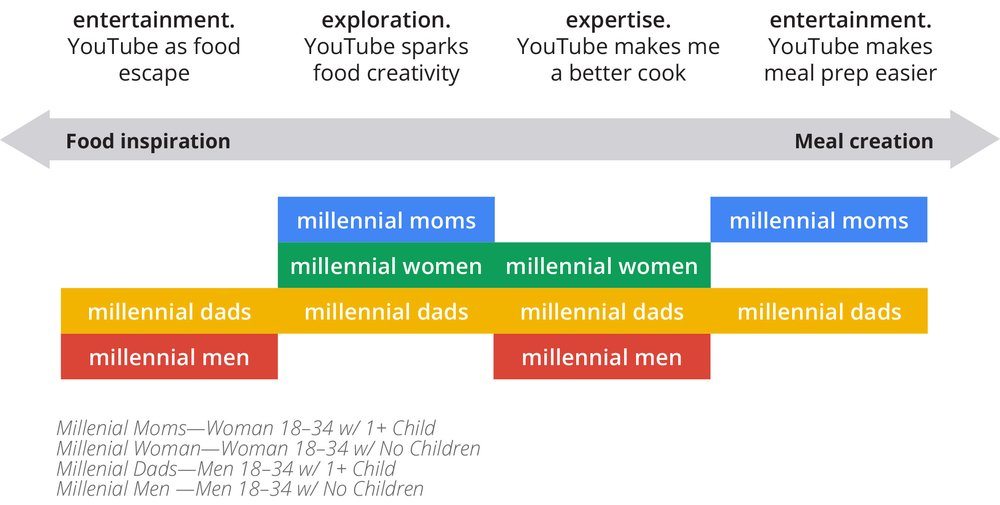
Social Media
Aside from YouTube, other social media channels offer another indispensable way to connect content to purchasing opportunities. UK supermarket Waitrose, for instance, features regular photos of meals that you can make at home on its Instagram feed. All the recipes featured are available via a link in the account bio – and the link takes customers directly to a page within the online shop.
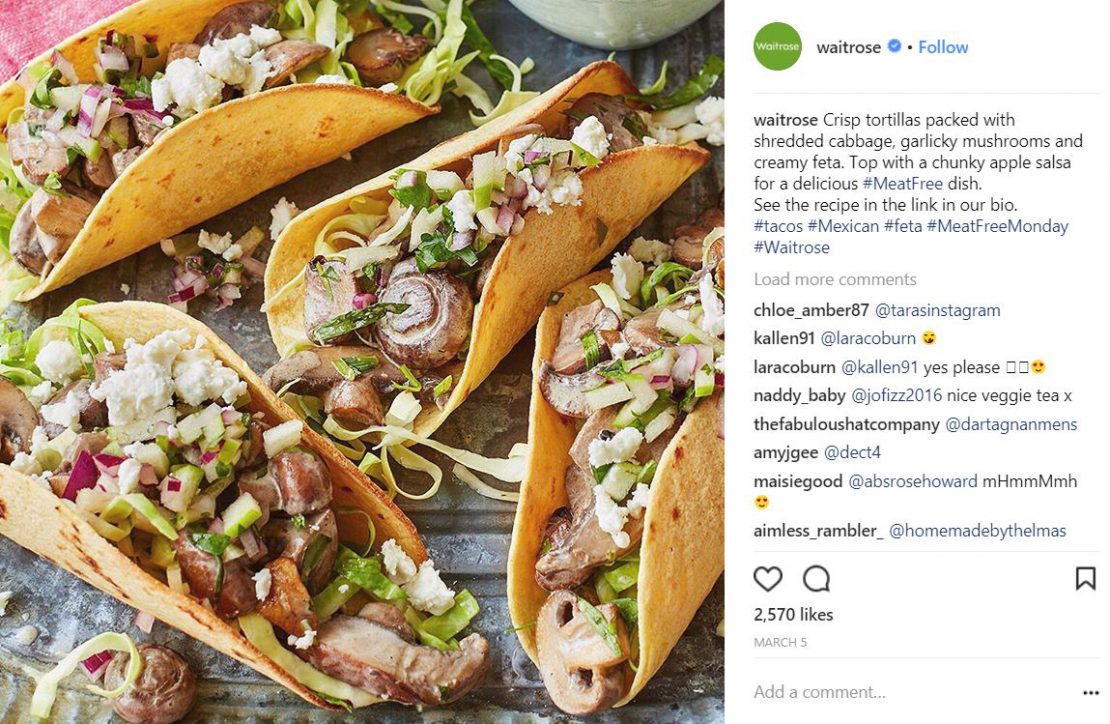
The Waitrose Instagram feed also provides plenty of opportunities for network marketing, as seen above. Followers of the feed can readily share and tag favourite recipes with friends and family members.
Again, this could be made even more personal by using referral source targeting to recognise where the customer had arrived from and mirror the message that had brought them there. Recipe box service SimplyCook does a great job of tailoring offers based on channel – for example, offering those who arrive via Facebook a trial box for just £1 in exchange for their email address. This generated over 7k new leads ready for re-engagement and nurture.
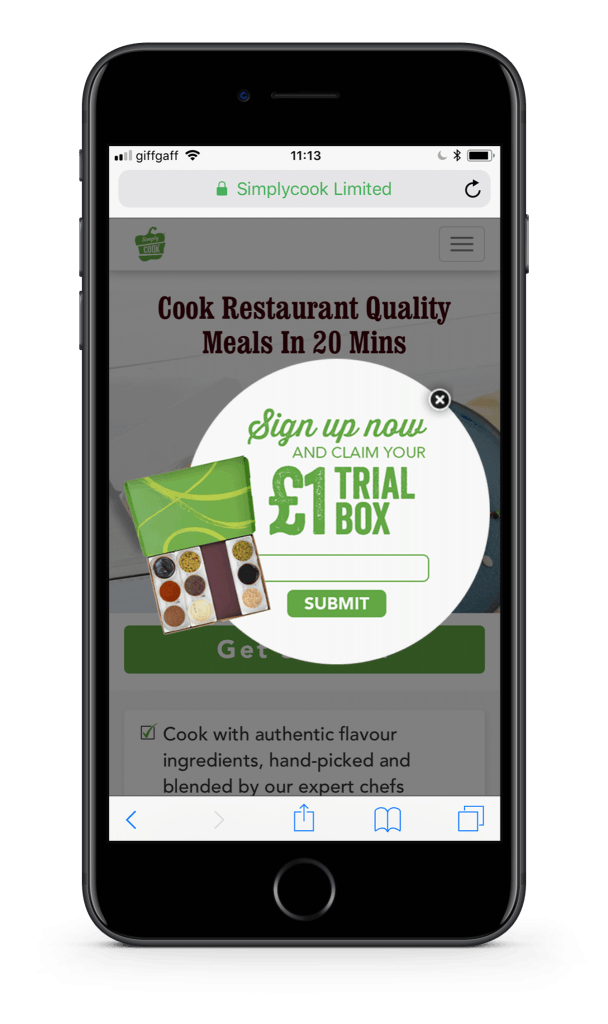
While social is often a big focus for content marketing, email remains one of the most effective digital marketing channels around. Newsletters are one effective way to share content and encourage engagement with your brand, but first you need to get that email address – but how do you do this effectively?
In food and beverage retailing, where loyalty is a growing problem, collecting email addresses for remarketing is more important than ever. Think about who you want to target, and what you can offer them in return for their details.
For example, Heartier, an online grocer, worked with Yieldify to identify a group of visitors to target – returning visitors. Whilst an overlay notification offered first-time customers a discount, those customers coming back to the site were encouraged to sign up to a newsletter that would provide them with recipes, tips and further special offers. The newsletter also shares supplier stories that speak to conscious consumers and encourage them to purchase products through the website.
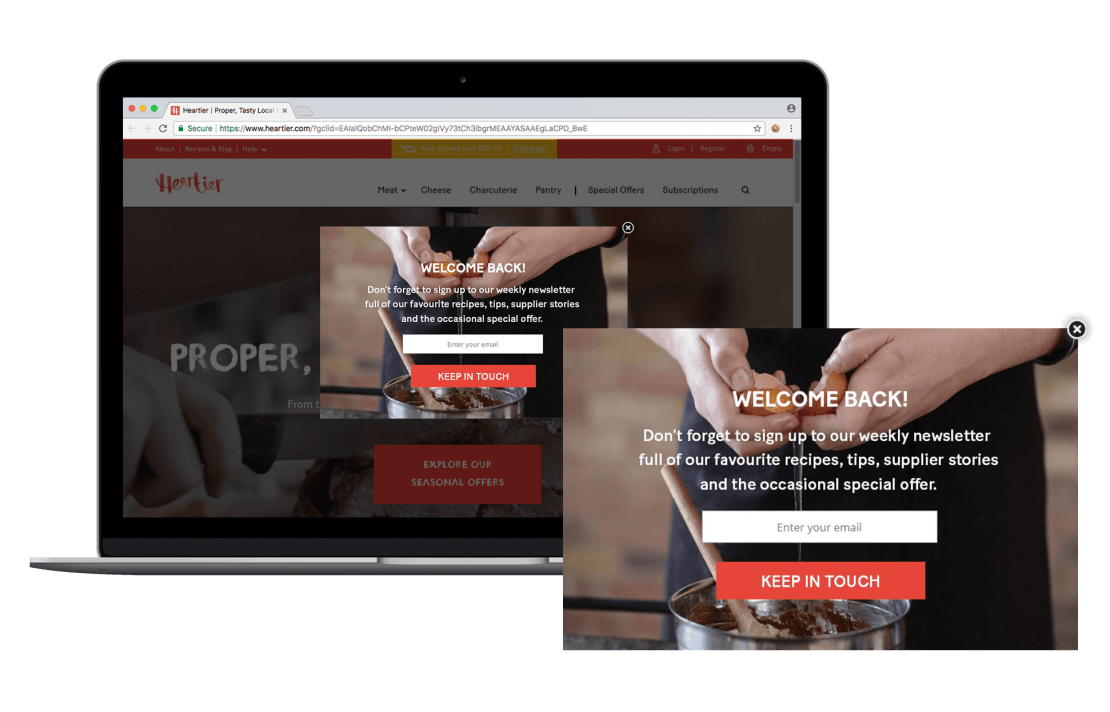
Farmison & Co uses content to build a customer journey from its recipe and community site through to its commercial site. Jennifer Hey, Head of Digital & Customer Experience, explains:
“The content on our Recipe and Community site is instrumental in our organic marketing strategy. A very large proportion of our traffic onsite starts off here, so its key that we try and get users from this part of the website and on to our ‘commercial’ website.
It’s also really important that we know who (from within our database) signed up here so we can offer a more personalised customer experience. We use Yieldify to surface a ‘Welcome’ offer incentive, which then connects back to the commercial site. These sign-ups then go into a seperate ‘recipe’ welcome journey and we’re able to target these customers with more recipe content than our sign-ups from our commercial site.”
Cost
Whilst it is certainly true that many customers would consider spending more for higher quality, more socially engaged products, there is still a high demand for value purchases in the marketplace. Over the summer of 2017, Aldi and Lidl accounted for £1 in every £8 spent in UK supermarkets, with two-thirds of British shoppers visiting them.
At the other end of the market, takeaway food, usually known for being expensive has been disrupted by the rise of aggregator sites such as Just Eat in the UK and, in the US, Grubhub. With so many consumers now treating these as their first port of call (Just Eat alone saw a 45% revenue increase in 2017), excluding your business from such a lucrative system seems like an impossible option, but they can eat into profit margins. So how can grocery and takeaway retailers ensure they are catering to discount-hungry, value-conscious shoppers?
Smarter Discounting
There are a number of ways to use discounting as a means of securing conversions or increasing average order value. A smart strategy from Domino’s utilized a three-tiered approach to improve conversions, with different offers targeted at customers showing intent to leave the website based upon the value of their cart. The campaign saw a 16% increase in conversions over one month.
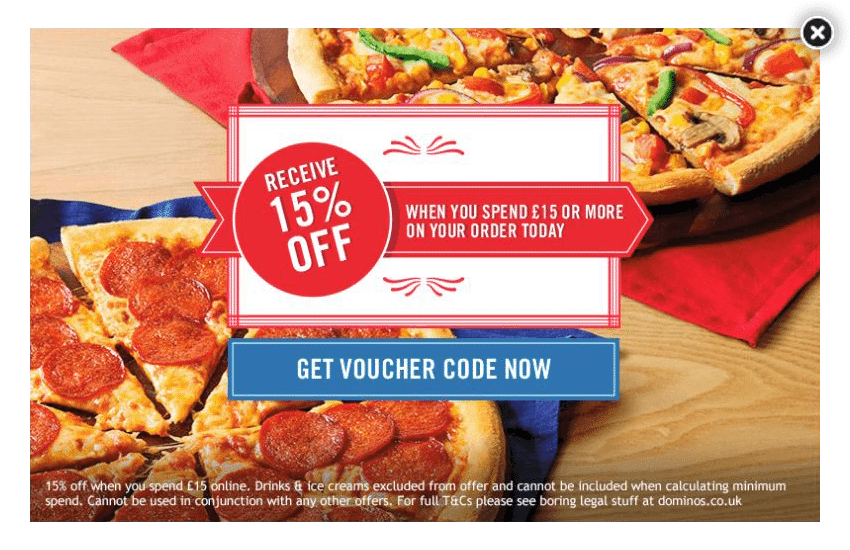
Another approach that would work similarly would be to relate the customer’s costs back to delivery, as we saw earlier, and implement a spending threshold for free or discounted delivery.
Flexible Plans
Subscription box businesses, whether they’re delivering meal kits or niche products, often struggle with retaining customers beyond the first delivery as a result of cost concerns on the customer’s end. Most businesses in this field offer a free or heavily discounted first box, which draws value-aware customers in, only for them to cancel before the full priced subscription begins.
Earlier, we saw how Graze offers a free 5th and 10th box to some new customers to entice them to stick with the subscription, but a more sustainable way is to offer the ability to pause subscriptions.
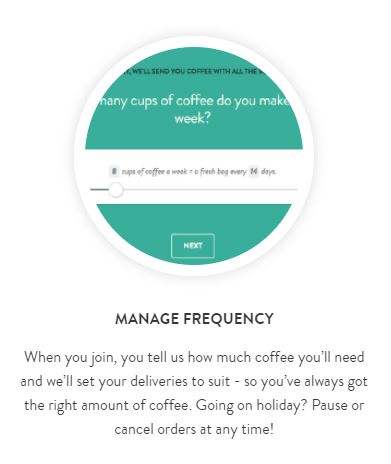
Pact Coffee, a specialist subscription box company, makes it clear from the outset that the customer can pause their subscription at will. This type of flexibility can be a great way to ensure that customers aren’t lost forever if they simply want to cut costs one month.
Utilizing Urgency
Food and beverage companies are well-placed to utilize urgency tactics precisely because of the nature of the products – they are perishable, and usually required by a certain date. On top of this, most food is seasonal, and so prices and availability will fluctuate across the year.
Food-focused holidays like Christmas, Easter, or more loosely defined seasons such as Back to School or BBQ season, offer a great opportunity to experiment with urgency based offers – already something customers are used to from shopping in-store. Caviar, a US-based local food delivery service, took advantage of the change to daylight savings time with a limited time offer of free delivery:
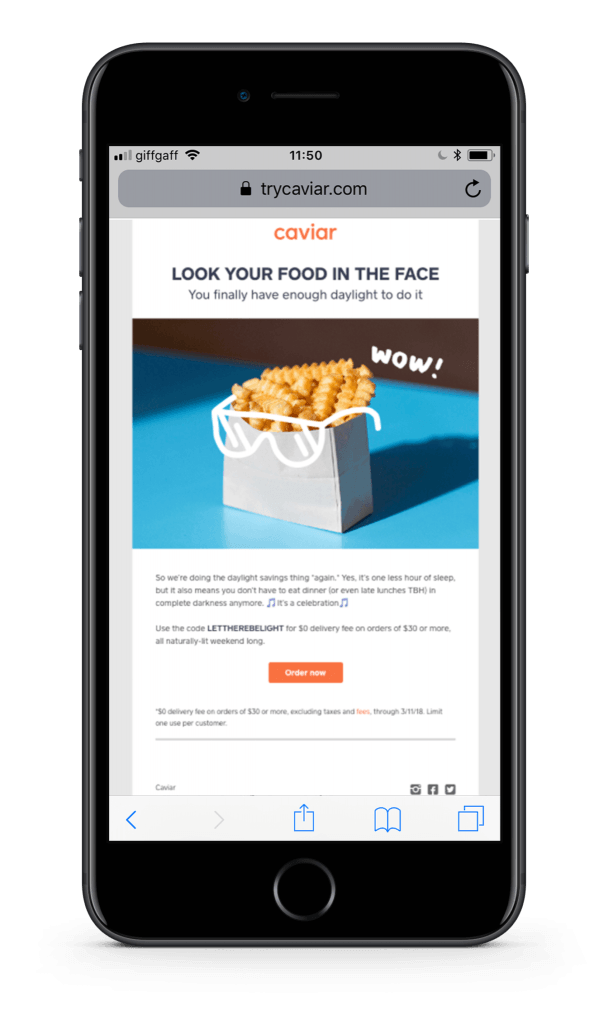
Conclusion
E-commerce in food and drink is about identifying what your customers want, and how you are able to better serve them than traditional brick-and-mortar stores and your other online competitors.
As we’ve seen, considering the five ‘ingredients’ we’ve examined above is the first step towards earning – and retaining – customers for your business. Ask yourself the below questions, and you’ll be on your way to better understanding your customers:
- Convenience: what can you do to make your customer’s journey easier?
- Choice: how can you help your customers find what they need?
- Conscious consumption: how can you best demonstrate your values?
- Content: which formats can you utilize to reach potential customers?
- Cost: what can you do to encourage conversions and increase average order value, without harming margins?